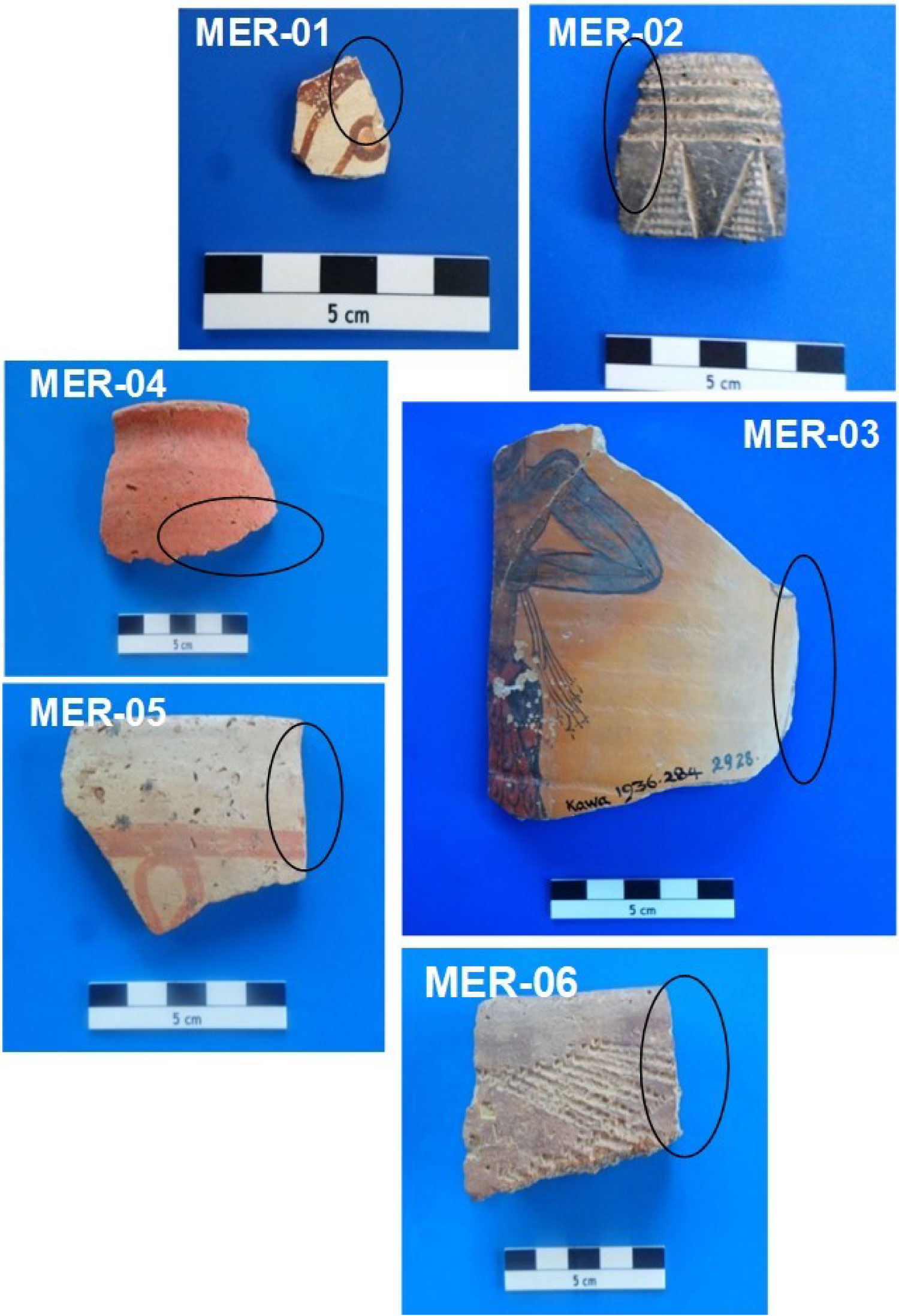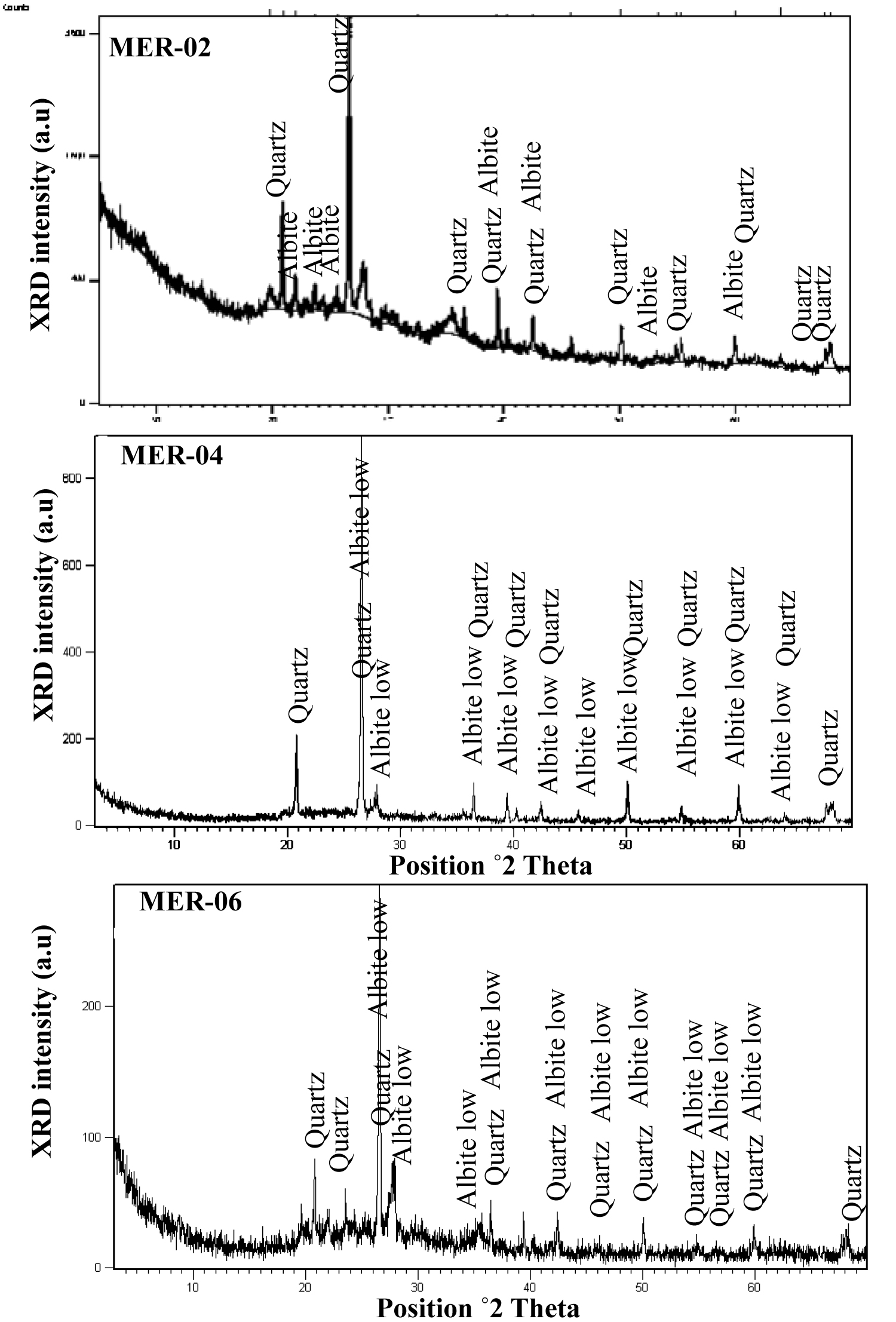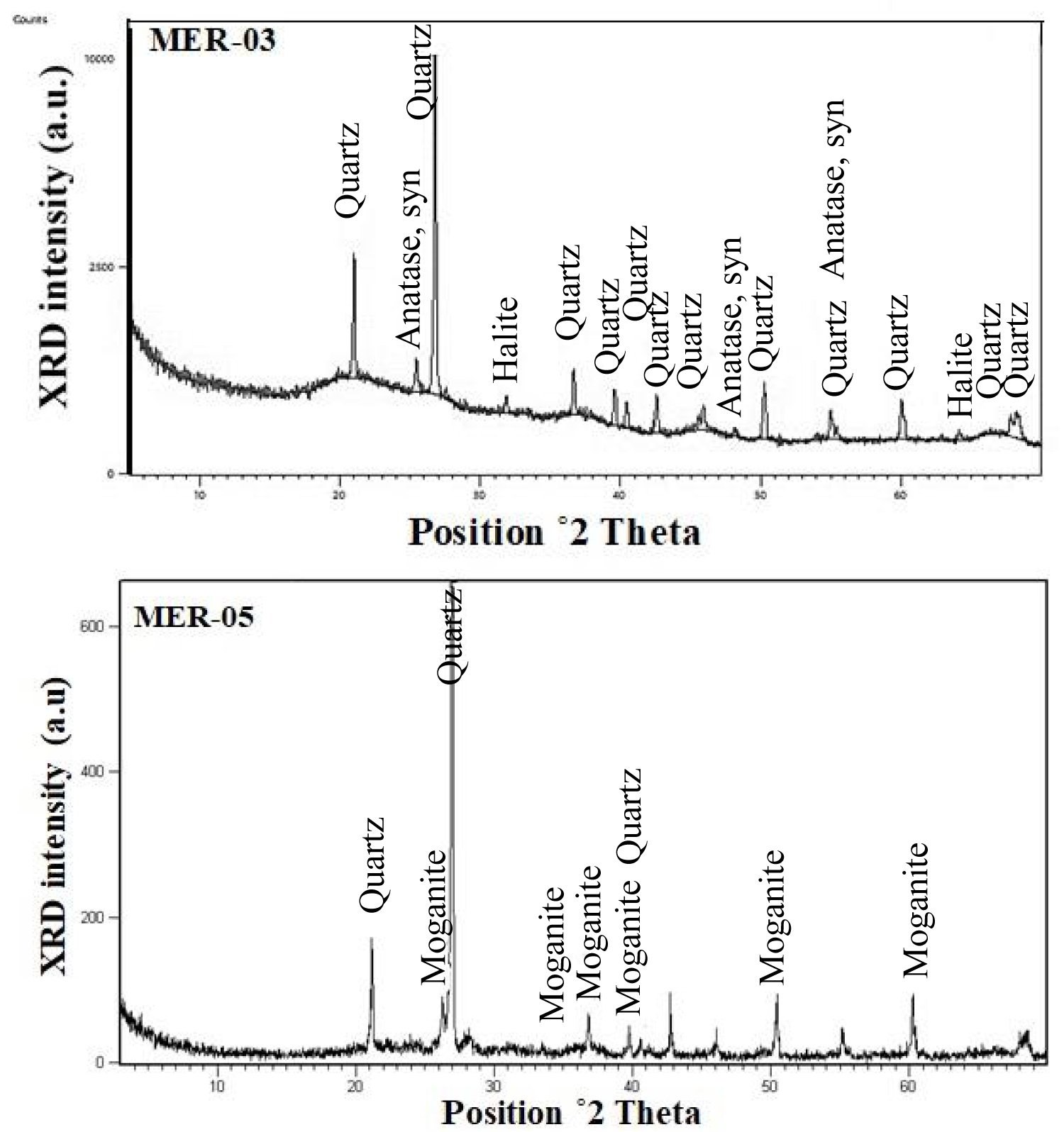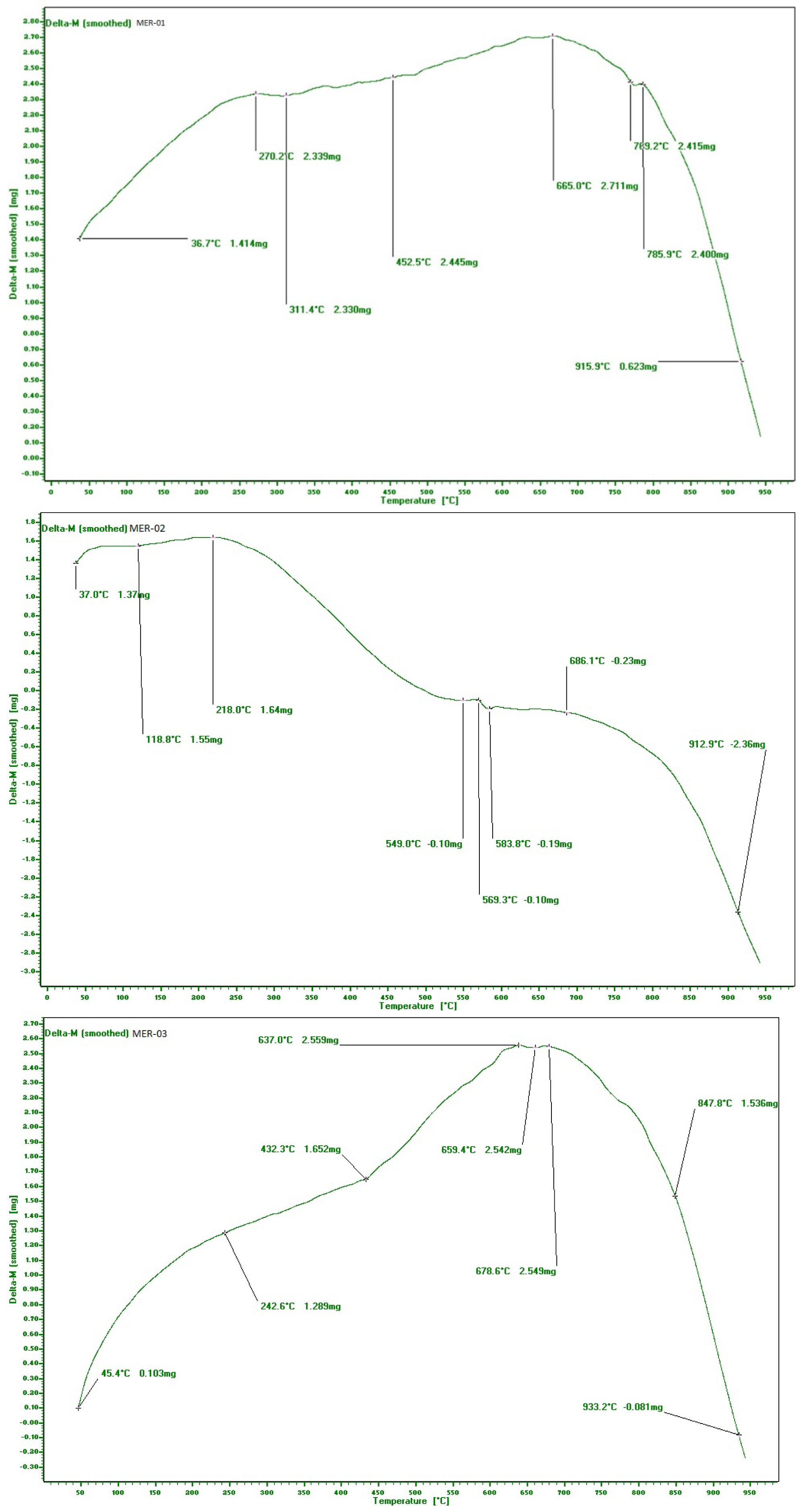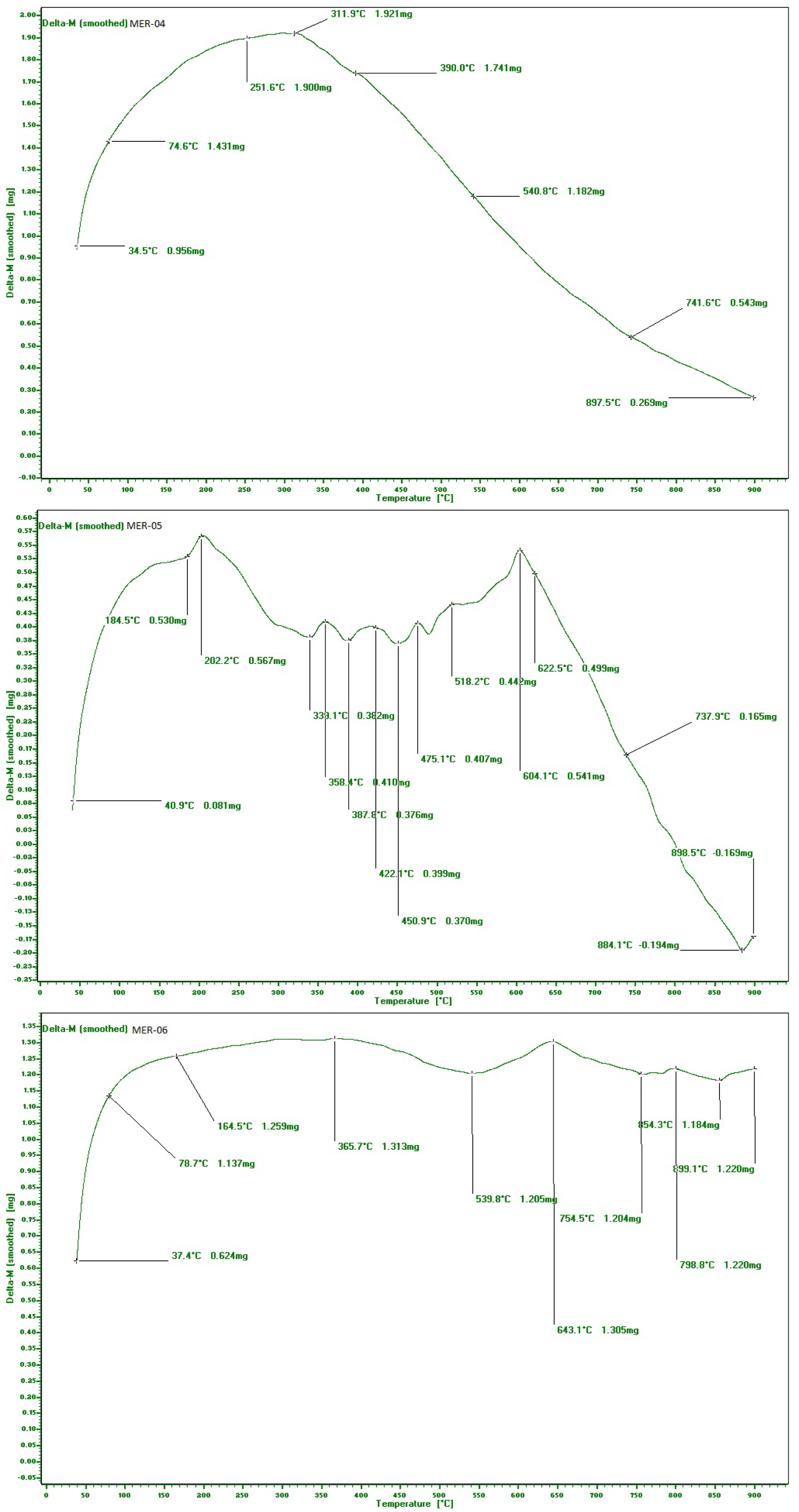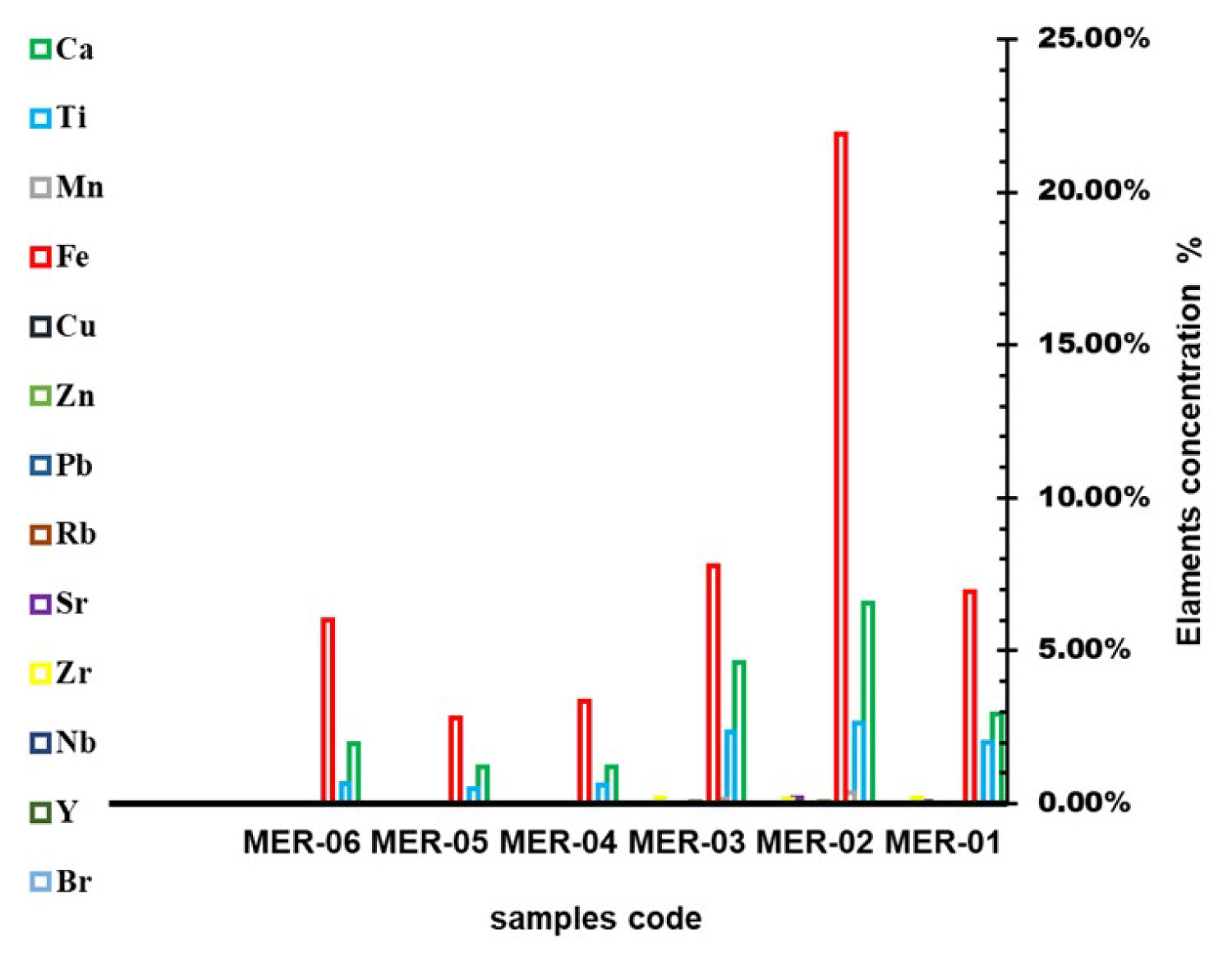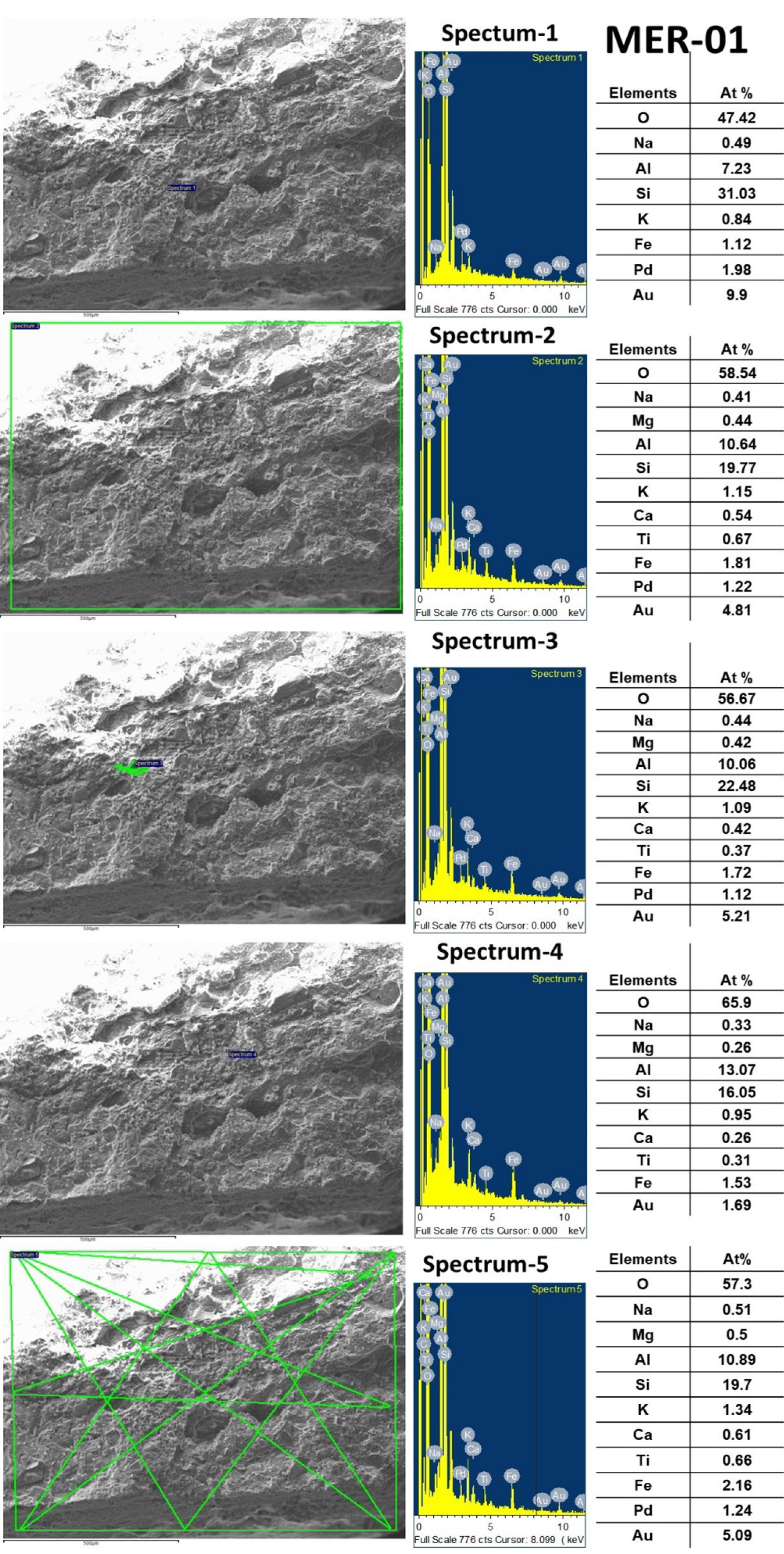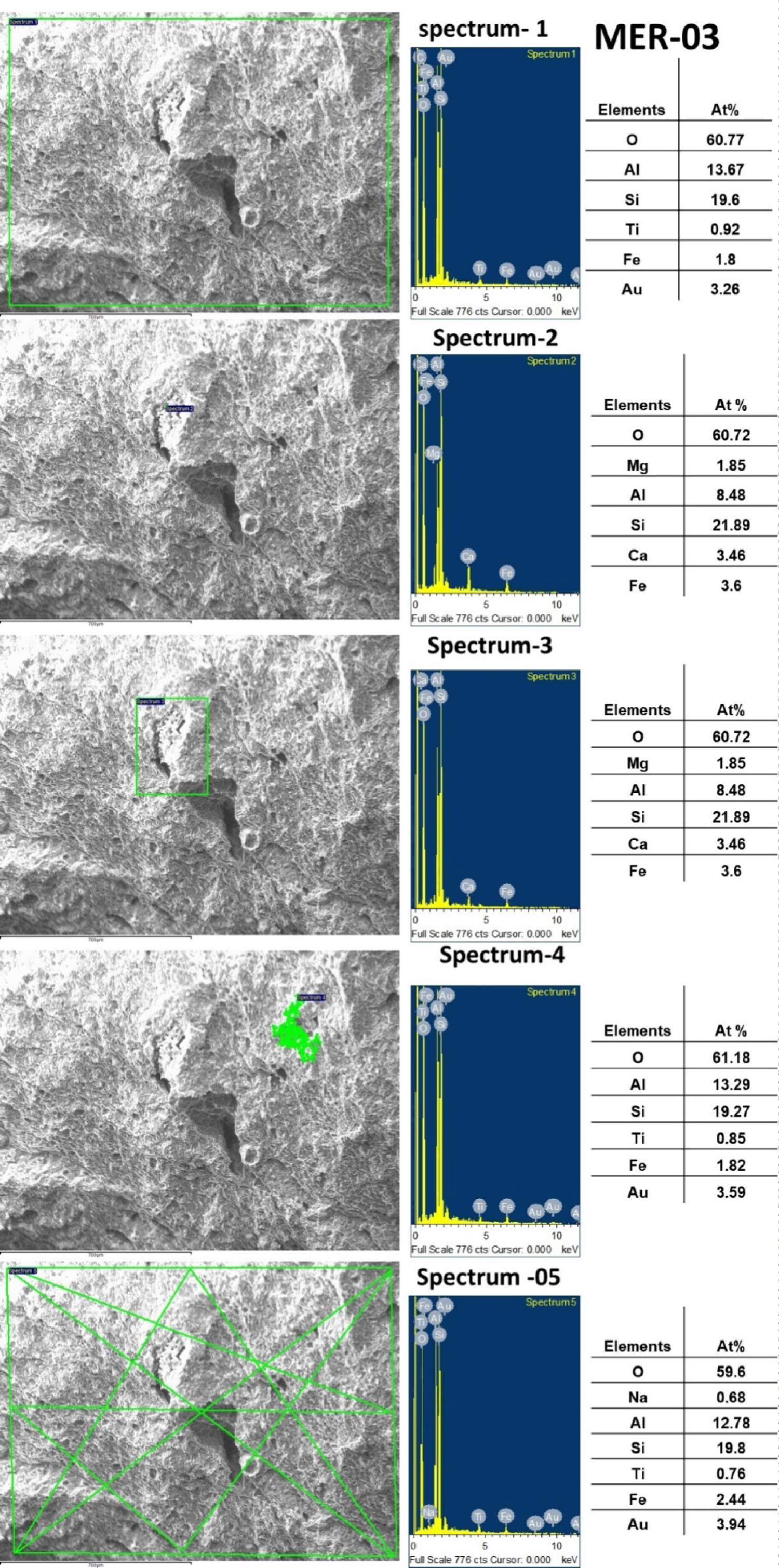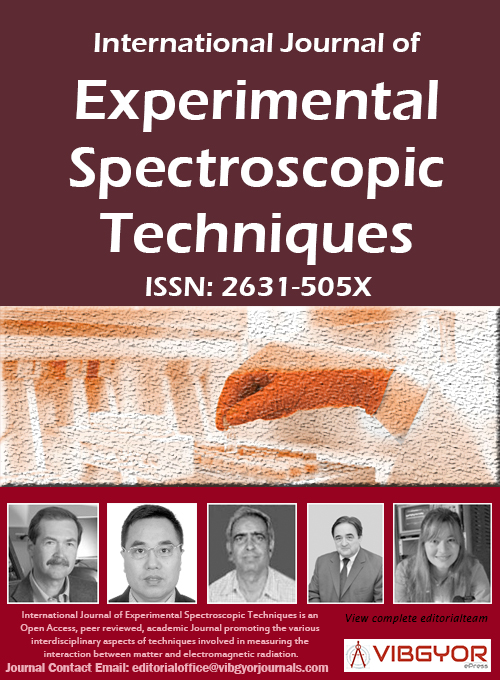
International Journal of Experimental Spectroscopic Techniques
(ISSN: 2631-505X)
Volume 4, Issue 1
Research Article
DOI: 10.35840/2631-505X/8523
Multi-Analytical Approach for Characterization of Archaeological Meroatic Potsherds
Fatima Elbashir Siddig1, Abdalla Ahmed Elbashir1* and Verena Lepper2
Table of Content
Figures
Tables
Table 1: Description of pottery samples.
Table 2: FT-IR wavenumbers (cm-1) of potsherds with corresponding vibrational assignments.
Table 3: XRD mineralogical composition of the samples.
References
- G Emberling (2004) Sudan: Ancient Treasures: An exhibition of recent discoveries from the Sudan National Museum. British Museum Publications Limited.
- K Priese (1997) The Kingdom of Napata and Meroe, Flammarion. SAKN, Paris-New York.
- WY Adams (1964) An introductory classification of Meroitic pottery. Kush 12: 126-173.
- E Garzanti, S Andò, G Vezzoli, AAA Megid, A El Kammar (2006) Petrology of Nile River sands (Ethiopia and Sudan): Sediment budgets and erosion patterns. Earth Planet Sci Lett 252: 327-341.
- RBJ Mason, K Grzymski (2009) Petrography of Pottery from Meroe, Sudan. Sudan & Nubia, 13: 87-91.
- C Ting, J Humphris (2017) The technology and craft organisation of Kushite technical ceramic production at Meroe and Hamadab, Sudan. J Archaeol Sci Reports 16: 34-43.
- P Baraldi, C Baraldi, R Curina, L Tassi, P Zannini (2007) A micro-Raman archaeometric approach to Roman wall paintings. Vib Spectrosc 43: 420-426.
- S Shoval (2003) Using FT-IR spectroscopy for study of calcareous ancient ceramics. Opt Mater 24: 117-122
- LM Shillito, MJ Almond, K Wicks, LJR Marshall, W Matthews (2009) The use of FT-IR as a screening technique for organic residue analysis of archaeological samples. Spectrochim Acta A Mol Biomol Spectrosc 72: 120-125.
- R Ravisankar, S Kiruba, A Chandrasekaran, A Naseerutheen, M Seran, et al. (2010) Determination of firing temperature of some ancient potteries of Tamil Nadu, India by FT-IR spectroscopic technique. Indian J Sci Technol 3: 1016-1019.
- R Ravisankar, G Raja Annamalai, A Naseerutheen, A Chandrasekaran, MVR Prasad, et al. (2013) Analytical characterization of recently excavated megalithic sarcophagi potsherds in Veeranam village, Tiruvannamalai dist., Tamilnadu, India. Spectrochim Acta - Part A Mol Biomol Spectrosc 115: 845-853.
- M Bayazit, I Iskender, A Issi (2015) Investigating the firing technologies of Part-Roman potsherds excavated from Kuriki (Turkey) using thermal and vibrational spectroscopic techniques. Vib Spectrosc 78: 1-11.
- LF Vieira Ferreira, I Ferreira Machado, AM Ferraria, TM Casimiro, P Colomban (2013) Portuguese tin-glazed earthenware from the 16th century: A spectroscopic characterization of pigments, glazes and pastes. Appl Surf Sci 285: 144-152.
- D Eniu, C Gruian, E Vanea, L Patcas, V Simon (2014) FTIR and EPR spectroscopic investigation of calcium-silicate glasses with iron and dysprosium. J Mol Struct 1084: 23-27.
- P Singh, S Sharma (2016) Thermal and spectroscopic characterization of archeological pottery from Ambari, Assam. J Archaeol Sci Reports 5: 557-563.
- JD Cashion, CA Hope, WH Jay (2015) Complementary raman and Mössbauer Archaeological studies. 39th Annu Condens MATTER Mater Meet, Australia, 3-6.
- NQ Liem, G Sagon, VX Quang, H Van Tan, P Colomban (2000) Raman study of the microstructure, composition and processing of ancient Vietnamese (proto) porcelains and celadons (13 - 16th centuries). J Raman 31: 933-942.
- HB Lucas, HJA Silva, CMS Tasayco, P Munayco, JLB Faria (2018) Archaeological pottery from Nasca culture studied by Raman and Mössbauer spectroscopy combined with X-ray diffraction. Vib Spectrosc 97: 140-145.
- SV Sajeev, K Ramaswamy (2011) Transform infrared spectroscopy a study of firing temperature of some ancient ceramic wares using fourier transform infrared spectroscopy. AIP Conference Proceedings 137: 22-25.
- S Shoval, P Beck (2005) Thermo-FTIR spectroscopy analysis as a method of characterizing ancient ceramic technology. J Therm Anal Calorim 82: 609-616.
- D Seetha, G Velraj (2015) Spectroscopic and statistical approach of archaeological artifacts recently excavated from Tamilnadu, South India. Spectrochim Acta - Part A Mol Biomol Spectrosc 149: 59-68.
- O Ponta, A Vulpoi, VV Zirra, S Simon (2016) Structural and compositional investigation of ancient ceramics from a fortified settlement in south-western Romania. J Mol Struct 1122: 157-163.
- R Ravisankar, S Kiruba, C Shamira, A Naseerutheen, PD Balaji, et al. (2011) Spectroscopic techniques applied to the characterization of recently excavated ancient potteries from Thiruverkadu Tamilnadu, India. Microchem J 99: 370-375.
- G Raja Annamalai, R Ravisankar, A Rajalakshmi, A Chandrasekaran, K Rajan (2014) Spectroscopic characterization of recently excavated archaeological potsherds from Tamilnadu, India with multi-analytical approach. Spectrochimica Acta Part A: Molecular and Biomolecular Spectroscopy 133: 112-118.
- L Damjanović, I Holclajtner-Antunović, UB Mioč, V Bikić, D Milovanović, et al. (2011) Archaeometric study of medieval pottery excavated at Stari (Old) Ras, Serbia. J Archaeol Sci 38: 818-828.
- VA Drebushchak, LN Mylnikova, TN Drebushchak (2011) The mass-loss diagram for the ancient ceramics. J Therm Anal Calorim 104: 459-466.
- S Shoval, Y Paz (2013) A study of the mass-gain of ancient pottery in relation to archeological ages using thermal analysis. Appl Clay Sci 82: 113-120.
- GE De Benedetto, R Laviano, L Sabbatini, PG Zambonin (2002) Infrared spectroscopy in the mineralogical characterization of ancient pottery. Journal of Cultural Heritage 3: 177-186.
- AM Musthafa, K Janaki, G Velraj (2010) Microscopy, porosimetry and chemical analysis to estimate the fi ring temperature of some archaeological pottery shreds from India. Microchem J 95: 311-314.
- Iordanidis, J Garcia-Guinea, G Karamitrou-Mentessidi (2009) Analytical study of ancient pottery from the archaeological site of Aiani, northern Greece. Mater Charact 60: 292-302.
- Barış Semiza, Bahadır Duman, Mehmet Ok (2018) Analytical study of Roman red slip ware from ancient Tripolis (Denizli, Turkey). Measurement 129: 530-541.
- Y Maniatis, MS Tite (1981) Technological examination of Neolithic-Bronze Age pottery from central and southeast Europe and from the Near East. J Archaeol Sci 8: 59-76.
- Y Maniatis, MS Tite (1975) A Scanning electron examination of the bloating of fired clays. J Br Ceram Soc 74: 229-232.
Author Details
Fatima Elbashir Siddig1, Abdalla Ahmed Elbashir1* and Verena Lepper2
1Department of Chemistry, Faculty of Science, University of Khartoum, Khartoum, Sudan
2Ägyptisches Museum und Papyrussammlung, Staatliche Museen zu Berlin - Preußischer Kulturbesitz, Germany
Corresponding author
Abdalla Ahmed Elbashir, Department of Chemistry, Faculty of Science, University of Khartoum, Khartoum, Sudan, Tel: +249912989405.
Accepted: March 23, 2019 | Published Online: March 25, 2019
Citation: Siddig FE, Elbashir AA, Lepper V (2019) Multi-Analytical Approach for Characterization of Archaeological Meroatic Potsherds. Int J Exp Spectroscopic Tech 4:023.
Copyright: © 2019 Siddig FE, et al. This is an open-access article distributed under the terms of the Creative Commons Attribution License, which permits unrestricted use, distribution, and reproduction in any medium, provided the original author and source are credited.
Abstract
In this paper, the results obtained using a multi-analytical approach for characterization of six potsherds originally attributed to the 4th century BC excavated from Meroatic sites, Sudan were reported. Sort of the minerals and their structural deformation during the production forming process from the raw material used by artisan to ware were performed, in the particular, the maximum heating temperature obtained during burial and operative condition (open or close condition) of the kiln were performed by Fourier Transform Infrared Spectroscopy (FT-IR), X-Ray Diffraction (XRD) and thermogravimetric analysis (TGA) was the completing analysis to estimate the firing temperature from typical thermal reactions in potsherds. Further X-ray Ray Fluorescence, Scanning Electron Microscope (SEM) coupled with Energy Dispersive X-ray spectrometer (EDX) were used to analyze the morphology, chemical composition and find subsequent progress of vitrification levels. The XRD results give supportive information obtained from the FT-IR spectra. X-ray diffractometry results have shown the existence of quartz, albite (MER-02, MER-04, MER-06) anatase (MER-03) and manganite (MER-05) minerals. Thus, the mineralogical structure of a potsherds samples has a quite dissimilar composition that could suggest that different source of the raw material utilized for the potsherds production. Clay minerals can be used for re-establishment of previous production conditions. In the present paper TGA, FT-IR and XRD results potsherds are examined and information derived on potsherds technologies regarding raw materials and production conditions is confirmed by SEM observations relating to the extent of vitrification. The temperature at which potsherds were fired differs over range (700-900 ℃) depending on the sort of clay used and the kiln existing. The obtained data point out that the investigated potsherds were made from different raw materials and workshops.
Keywords
FT-IR, XRD, XRF, SEM-EDX, TGA, Potsherds
Introduction
Meroe is located on the east bank of the Nile about 200 km north-east of Khartoum. The site contains the residues of the Royal City and close pyramid fields of the antique Kingdom of Kush [1,2]. Meroitic pottery is possibly the most broadly well-known culture creation of ancient Nubia, and it is rightly famed for the fine workmanship and unique decoration according to Adams [3]. The samples details shown in Table 1. General geological background to explanation somehow of the dissimilarity in the mineralogical composition of sites. The Nile, with its binary main branches - the White Nile and the Blue Nile - combine at Khartoum, runs over the county. The Atbara River, with its headstream in Ethiopia, arrives the main river system around 300 km north of Khartoum. The three branches have a different mineralogical composition, therefore donating to the variant in the mineralogical composition of the coming together area [4]. The White Nile brings rounded monocrystalline quartz with a minor quantity of feldspar, the sediments of the Blue Nile hold commonly mafic volcanic particles, K-feldspar, and biotite, besides the Atbara River donates volcanic rock remains augite, and olivine. The Nile alluvium in the areas north of the union is labeled considered as extra homogeneous, enclosing mineral sets of quartz, feldspars, amphiboles, clinopyroxenes, mica, round fragments of primary volcanic rock, and phytoliths of plants, which are mostly formed from weathering of the basaltic Ethiopian Hilltops [5]. The archaeological locations of the Royal City and Meroe have together situated were located in lengthways the eastern cut banks of the Nile: Meroe is located 150 km north northern of Khartoum [6].
The studies stimation of firing temperature and the type of atmospheric firing phase are suitable to give condition are important to provide us a well understanding of the civilization that made the potteries methods [7]. Fourier transform infrared spectroscopy (FT-IR) is a useful technique to study the minerals and their decomposition-transformation manners of pottery [8,9] estimate the firing condition [10] beside X-ray diffraction is alternative analytical instrument principally used for the mineral/phase investigation of potteries which informs us by the raw materials of the samples [11,12]. As well, XRF has experienced used too as co-dependent analysis that can be used, getting elements to range above Sodium to Uranium [13].
In the existent study, ancient potsherds were studied by many analytical approaches. XRD and FT-IR were used for the mineralogical characterization, XRF, SEM-EDX for morphological, structural and chemical assessment. XRF for the determination of the elemental composition and SEM-EDX for morphological, structural and chemical assessment.
Materials and Methods
Six ancient Meroitic potsherds (Figure 1) were dated toward the 4th century BC, the description of pottery samples listed in Table 1.
Fourier Transform Infrared Spectroscopy (FT-IR)
FT-IR is obtained with FT-IR 8400S Shimadzu (Japan) with a pyroelectric detector operating in the mid Infrared region (400-4000 cm-1) with a characteristic resolution of 4.0 cm-1 in transmittance mode, using KBr discs. The fixing of peaks and smoothing were performed by IR-solution software in the device done the working window 4000-400 cm-1.
X-ray diffraction (XRD)
X-ray diffraction (XRD) analysis was performed by EXPERT-PRO diffractometer system, the Goniometer: PW3050/60 (Theta/theta), using Cu Kα (λ = 1.54060 Å). The diffraction patterns were done at 2θ angle, within range 3-70° with step size [°2θ] = 0.0200 at a scan step time 0.5 s. The measuring temperature of 25 ℃, the generator sitting 40 mA, 50 KV. The X'Pert High Score plus software was performed for diffraction data explanation.
Thermogravimetric analysis (TGA)
Thermogravimetric analysis (TGA) was carried out by PT1000 Thermogravimetric LINSEIS with thermal advantage software. The experimentation was accomplished with a heating rate 10 ℃/min the samples heat up to 950 ℃ in high purity atmosphere.
X-Ray fluorescence (XRF)
Elemental components of the pottery were considered by X-ray fluorescence spectrometer (XRF), the samples grind down to the power by mortar and pestle, then 1 gram pressed in 2 cm2 circular disk. The X-ray isotopic source was used to measure the samples utilizing 109Cd which has regular energy 22.6 Kev. Si (Li) detector, The CANBERRA amplifier model 2020 with high voltage supply 600 V.
Scanning Electron Microscope-Energy Dispersive X-ray (SEM-EDX)
The microphotograph analysis was performed on an EVO ® LS 10 scanning electron microscope at 20 KV an accelerating voltage and 1-3 nA a beam current. The fresh fraction of each sample coated with a thin layer of palladium/gold. The extreme magnification in the technique is 1000.0000 times. The elemental investigation was performed by using the Oxford INCA EDX energy dispersive spectrometer, for the characterization of the X-ray emitted by the sample to examine the elemental chemical composition currently identified by SEM.
Results and Discussion
Mineral analysis
The mineralogical composition of the investigated potsherds was carried out by FT- IR and XRD techniques. The FT-IR results are shown in (Figure 2) and listed in Table 2 within range 400-4000 cm-1. While XRD spectra are presented in (Figure 3a and Figure 3b) and the crystalline minerals of XRD results listed in Table 3. The absorption band around 1640 cm-1 is frequently assigned to O-H bending vibration and also can arise from vibrations of the SiO2 network and is frequently hidden by water O-H band. The absorption band around 1640 cm-1 is frequently assigned to O-H bending vibration of water O-H band [14]. The existence of the band around 535 cm-1 in both (MER-01, MER-04) samples, revealed that, the presence of iron oxides. Which indicated that point out these samples, they were fired in the temperature more than 750 ℃ in open atmosphere firing condition and it is may confirmed from the red color of the potsherds samples [11,15]. While sample MER-05 contains monganite which may suggest the firing temperature between 800-900 ℃ [16]. While MER-03 sample contains anatase, which is a common thermal stable phases impurity of both clays and sands [13]. Anatase, a TiO2 polymorph which is commonly formed over the gel or hydrothermal technique still regularly present in linkage with brookite, albite and quartz. Indeed, this phase of titanium oxide mostly transforms into rutile which is a mineral from which up to 70% of titanium oxide at about 850 ℃ [17], thus, this polymorph be able to use to determine the firing temperature of ceramic [18].
Quartz basal reflection in XDR at (4.26, 2.28, 2.24, 1.85, 1.54 and 1.45 Å) while in FT-IR in the band at 694 cm-1 is linked to vibrations of Si-O bonds in mineral quartz [19], and quartz occurrence is also showed by the doublet at around 777 and 798 cm-1 [20]. Besides, the absorption bands at 475 cm-1 assigned to bending vibrations of Si-O, Al-O bonds perform [21]. The bands 645 cm-1 band is due to Al-O stretching vibrations in AlO6 octahedra [22] while the band at 877 cm-1 (MER-01) attributed to the existence of calcite [12] and dehydroxylation of kaolinite minerals which is accomplished at 800 ℃ plus octahedral sheet structure in the clay minerals missing [23]. The existence of albite band about 435 cm-1 shows feldspar approving with XRD reflection of the Albite (4.65, 4.03, 3.63, 3.24, 3.19, 3.18, 2.93, 2.83, 2.73 and 1.97 Å (in the samples (MER-02, -04, -06) [23,24] shown in (Figure 3a).
The statement of the FTIR spectra pattern is in agreement with the literature, the thing makes FT-IR informative is that the ability of detection of any amorphous components in the sample while XRD can analysis only crystalline phases and agreements information about the typical structure, disordered SiO4 tetrahedra in usually amorphous phases that formed through clay firing will moreover broaden this band In the firing process structural changes that happen will disturb the point of Si-O stretching and deformation bands in FTIR results [25]. The Si-O stretching bands at around 1000 cm-1 in the FTIR spectra of all pottery samples (Figure 2) shifts towards higher frequencies with increasing temperature, bands (1037, 1031 and 1041 cm-1) in the samples (MER-01, MER-02 and MER-06) respectively at 700 ℃. While the bands (1085, 1076 and 1081 cm-1) in the samples (MER-03, MER-04 and MER-05) at 900 ℃. that, it is possible to estimate the firing temperature range of the samples as 700-900 ℃, this excellent agreement with the assumption resulting from XRD and SEM-EDX [25].
Thermogravimetric analysis (TGA)
Characteristic thermal analysis curves (TGA), of the potsherds observed in heating up to 900 ℃ are shown in (Figure 4a and Figure 4b). TGA results was a complementary study to estimate the firing temperature from the specific thermal reaction in potsherds under controlled firing atmosphere combined with other spectroscopic approaches like FT-IR and XRD, for the investigation of pottery samples [11,24].
The figure characterizes the thermograms of non-calcareous (calcite-free) and calcareous (calcite-rich) potsherds. The mass-loss as a result of the thermal manner was determined by the thermogravimetric analysis (TGA). The peak pause of the dehydration and dehydroxylation were firm according to Drebushchak, et al. [26]. The peak interval of the dehydration is defined from RT (room temperature) to 350 ℃ and the dehydroxylation from 350 to 600 ℃. Even if in some potsherds dehydroxylation is not clear, the exterior of mass-loss in the TGA curves in the temperature interval of 350-600 ℃ indicates that this process takes place and can be measured. In pottery containing calcite an additional mass-loss is detected in the interval from 600 to 850 ℃ because of decarbonation of the calcite in the potsherds [27].
X-Ray fluorescence (XRF) analysis
The elemental analysis obtained by XRF results of the six potsherds is shown in (Figure 5). it is obvious that the most abundant common elements are Ca, Fe, and Ti. The composition of Fe and Ca define the origin of the clay minerals and firing atmosphere adopted selected by the artisans. In particular, the nature of the clay whether calcareous (CaO > 6%) or non-calcareous (CaO < 6%) clay can be identified from the percentage of Calcium Oxides (CaO) from the XRF data, it should be noted that all the samples were non-calcareous, these suggestions show that the sources of the clay did not contain calcite [28,29].
Some trace elements like Mn, Zr, Ti, Nb might be used as geochemical 'fingerprints' guide, as they are related to particular petrological types [30]. The zirconium content is similarly small quantities in the samples most likely related to the igneous phases, upcoming from the granite and pegmatite regional rocks [31].
SEM-EDX analysis
The elemental concentration of the three potteries studied under SEM, beside EDX are given in (Figures 6, Figure 7 and Figure 8). The EDX indicated obviously point to low refractory clay [32] and all the three samples had relatively high iron content in agreement with the chemical analysis of XRF.
The sample (MER-01) did not reveal vitrification (Figure 6) from the elemental analysis shows, it is of the non-calcareous category, according to Maniatis and Tite [33], low refractory non-calcareous clay formed in oxidizing firing condition with no vitrification stage were fired < 800 ℃, The (MER-02) (Figure 7) and (MER-03) (Figure 8) samples revealed initial vitrification (IV) which supports to show the firing temperature is about 750-800 ℃ [33].
Furthermore, the elemental characterization by EDX spectroscopy (MER-03) (Figure 8) indication the existing of O, Na, Mg, Al, Si, K, Ca, Ti, Fe, Pd, and Au. The elemental concentration of these elements is summarized in beside table. In the spectrum 1 area (MER-03) the elemental composition only O, Al, Si were recognized in addition very small quantities of Ti, Fe, Au may this could be planted fiber, which could have arisen naturally in the Nile clay, it is as well probably that plant ingredients might be combined to the clay as temper [6]. The composition in the another grain spectrum 2,3 areas are approximately different (MER-03) respectively, contain Si, Al, O, Mg, Ca and Fe. Furthermore, the spectrum 4 area is containing also Al, O, Si as major elements besides Fe, Ti and Au. The results show various samples composition , due to different raw materials used and manufacturing techniques applied by artisans [22].
Conclusions
In this paper the multi-analytical approach has been used to study the potsherds excavated in the Meroitic archaeological sites in Sudan. The results obtained showed that potsherds were made with quite different raw materials. Quartz and feldspars mineral (Albite), anatase and moganite in the XRD analysis It is confirmed with FT-IR, TGA and SEM results. As a result, may show firing temperature at 700-900 ℃ in oxidizing atmosphere condition. The procedural approach was well applied to the mineralogical, chemical and thermal characterization of the potsherds samples.
The chemical composition of the trace elements revealed high concentrations of characteristic elements like Ti, Zr and Nb. A preliminary statement that the (MER-03) was prepared at a different workshop using different clay-beds could be drawn. The primary results of this study do not necessarily imply that all the pottery of those regions are appropriate to the same chronological form have similar physicochemical characteristics. This current archaeometrical research of pottery is predictable to deliver useful evidence on pottery folklore, line of work and cultural altercation through time.
Acknowledgments
All the authors would like to thank the Arab-German Young Academy of Sciences and Humanities (AGYA) for research funding.


